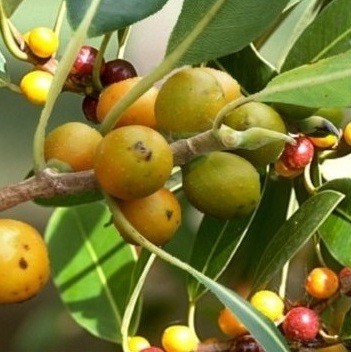Small-leafed Fig
(Ficus melinocarpa)

Description
Ficus obliqua, commonly known as the small-leaved fig, is a tree in the family Moraceae, native to eastern Australia, New Guinea, eastern Indonesia to Sulawesi and islands in the southwestern Pacific Ocean. Previously known for many years as Ficus eugenioides, it is a banyan of the genus Ficus, which contains around 750 species worldwide in warm climates, including the edible fig (Ficus carica). Beginning life as a seedling, which grows on other plants (epiphyte) or on rocks (lithophyte), F. obliqua can grow to 60 m (200 ft) high and nearly as wide with a pale grey buttressed trunk, and glossy green leaves. The small round yellow fruit ripen and turn red at any time of year, although ripening peaks in autumn and winter (April to July). Known as a syconium, the fruit is an inverted inflorescence with the flowers lining an internal cavity. Ficus obliqua is pollinated by two species of fig wasp—Pleistodontes greenwoodi and P. xanthocephalus. Many species of bird, including pigeons, parrots and various passerines, eat the fruit. The range is along the east coast from Queensland, through New South Wales in rainforest, savanna woodland, sclerophyll forest and gallery forest. It is used as a shade tree in parks and public spaces, and is well-suited for use as an indoor plant or in bonsai. All parts of the tree have been used in traditional medicine in Fiji.
Taxonomic tree:







